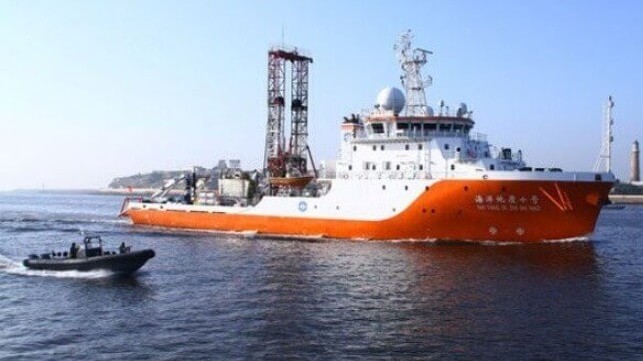Two Chinese Research Vessels Loiter at Energy-Rich Benham Rise

The government of the Philippines is responding to the presence of two Chinese research vessels at Benham Rise, a seamount in the Philippine Sea. The area is within the Philippine EEZ and has prospects as a future source of oil and gas.
Defense researcher and former U.S. Air Force officer Ray Powell spotted and publicized the presence of two Chinese research vessels in the Benham Rise area last week. He identified the ships as the Haiyang Dizhi Shihao and the Haiyang Dishi Liuhao, and said that they had departed Guangzhou on February 26.
The Shihao has a history of spending time in sensitive parts of the South China Sea. The vessel was identified loitering in the Indonesian EEZ in 2021, in close proximity to a working oil rig. (Unlike some similar situations in other neighboring states, the well was successfully completed, without diplomatic confrontation.)
To monitor Chinese activity at Benham Rise, the PCG has deployed the patrol vessel BRP Gabriela Silang on a two-week voyage to the area.
On Sunday, the Philippine Navy confirmed that the two Chinese vessels had departed the Philippine EEZ. It was not immediately possible to follow up with aerial surveillance because of foul weather, spokesman Roy Trinidad said, but another attempt was scheduled for Monday.
Trinidad emphasized that no laws were broken, and that the research vessels were transiting the area in compliance with UNCLOS.
China protests diplomat's "flashpoint" observations
China's ambitions to seize Taiwan are the primary focus of American military planners in the Pacific, but Philippine Ambassador Jose Manuel Romualdez recently told a conference panel that the Spratly Islands are the most important area to watch.
“The real problem and the real flashpoint, which is why I’m telling you how critical it is for us. The real flashpoint is in the West Philippine Sea,” Romualdez said. "All of these skirmishes that are happening [with China], there can be one major accident and either one of our countries, the US or the Philippines, can invoke the [mutual defense treaty] and when we do, a commitment made by the US or the commitment we made will happen, and then all hell breaks loose."
China's diplomatic corps and state media expressed outrage at Romualdez' remarks.
"It is deplorable that the said individual, in ignorance of basic facts, again used the South China Sea issue to hype up and launch a baseless accusation and malicious smear campaign against China," Chinese Embassy in Manila spokesperson Ji Lingpeng said on Sunday. "Who are stirring up the situation in the South China Sea? Who are spreading "China threat"? Who are ganging up in small blocks?"
Despite losing an international arbitral case, China claims the vast majority of the South China Sea as its own, including a large swath of the Philippines' western exclusive economic zone. Chinese government contractors have built a series of island military bases atop reefs in the Spratly Islands, providing bases for China's maritime militia and coast guard to enforce Chinese sovereignty claims in Philippine waters.
In 2016, the Permanent Court of Arbitration in the Hague ruled that China's excessive maritime claims are not consistent with international law. China refused to participate in the case and has ignored the outcome.
No comments:
Post a Comment